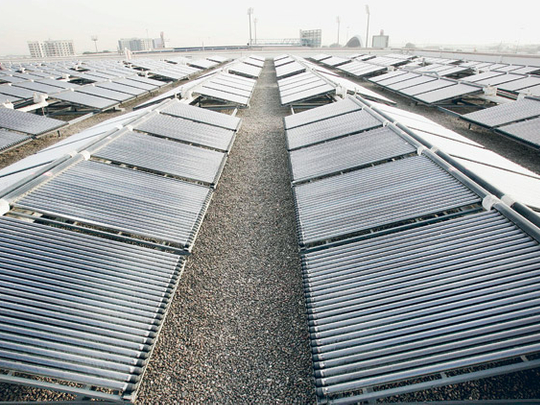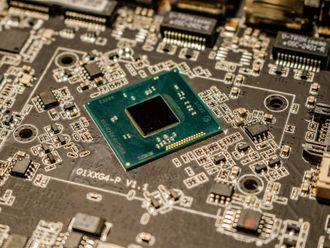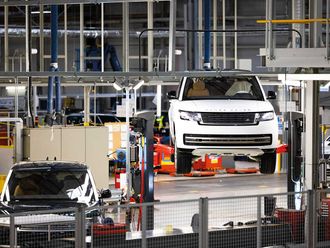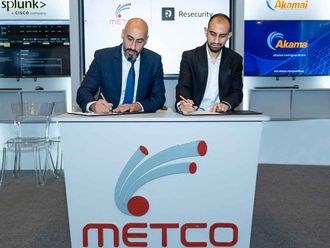
Dubai: If a concerted and sustained effort to heat up the country's fledgling solar energy industry has been missing, it's emerging right now.
Stakeholders hope that this push will ensure this energy source will at last get its rightful place under the sun.
This week sees the formal unveiling of the Emirates Solar Industry Association, an initiative of Abu Dhabi's Masdar Institute, which expects to bring together all the players in the industry to unleash the full potential the alternate energy resource offers.
Apart from those entities directly involved in solar energy — whether in photovoltaics (PV), concentrating solar power (CSP) or solar thermal — the new group also plans to create roles for suppliers to the industry such as glass, steel and engineering companies.
At the top of its agenda is the creation of nothing less than a full-blown solar "cluster" in the country and, by doing so, create business opportunities for its members.
The association will also come to the aid of international entities in the solar energy field that wish to set up bases in the country.
The fact that the initiative comes with the backing of Masdar Institute immediately raises its profile.
The entity has the necessary gravitas and more to channel the disparate voices within the local solar energy industry into a focused group that can wield a lot of clout.
"A non-governmental solar energy grouping will create a boom in the industry, allowing an environment where all private bodies can research and implement innovative technologies," said Prabissh Thomas, managing director at PTL Solar in Jebel Ali, which in the past has supplied Iraq with its solar solutions.
"Solar will light up the path for countries seeking energy independence and cost-effective means of energy generation," Thomas said.
"The solar energy grouping [in the UAE] will also create new jobs with specialist skill sets."
There is a lot to be said for the kind of traction that an industry grouping can provide, not the least of which is paving the way for fresh capacities to be added.
A theme the industry likes to repeat is that the cost to produce one watt of solar power drops by as much as 20 per cent each time the installed capacity doubles. In recent times, these capacities have been doubling every few years or so.
Not only that, the global solar industry is showing itself to be resilient to economic pressures.
"Supported by cost-cutting and efficiency improvements, the photovoltaics industry has managed to achieve a growth rate of 87 per cent, or 13.8 GW, of newly installed capacity in 2010," said a recent report by Bank Sarasin, the Swiss financial institution.
"At least eight new PV markets with a potential annual capacity of 500 MW are expected to be added over the next two years. The PV industry will therefore acquire the stability and political autonomy it needs to be able to continue to grow unimpeded and to enter new dimensions."
These markets would be France, Italy, Spain, the US, Canada, China, India and Japan.
Despite its location and the financial advantages, the Middle East has yet to take the necessary strides to put itself on the global stage in the solar energy industry.
With easy access to hydrocarbons on tap, there hasn't been a compulsion to change.
This is where entities such as the Emirates Solar Energy Association can make a difference, and make it count.
"I do believe the region as a whole is behind the ball concerning the use of solar energy and must catch up with the rest of the world," said Laurent de Morelos, managing director at Equilibre Group in Dubai, an alternate energy firm which says it has just landed a major contract in Mauritius.
"The UAE is located in the best part of the global sunbelt to collect valuable energy from the sun all year round. It is never too late and any action to develop solar energy projects in the UAE and the region should be encouraged by both the public and private sectors."
In the UAE, the public sector has historically taken the lead in alternate energy programmes and having the financial muscle to do so has been a key factor.
There's also the environmental aspect that governments cannot let slide from the agenda. All this is not to say private enterprises have no role, but it's been disparate and at best limited to date.
Can the private sector now step up to the plate?
De Morelos said: "It is quite essential for the renewable energy industry to come up with commercially viable projects which can be well received by the investor markets without relying on public sector support".
"Projects with a reasonable return on investment and low risk will certainly retain the attention of investors.
"It does take some thinking outside the box to design such economically viable project schemes. But it is possible," he said.
The Bank Sarasin report highlights concerns in European government circles and among consumers about the level of subsidies that solar energy projects are given.
Major cuts in those subsidies are expected in coming weeks.
"There is growing criticism from political circles and consumer pressure groups about the size and mounting costs of feed-in tariffs for solar power," the report said.
"Rising electricity prices and soaring public deficits are causing headaches for many governments in Europe, and solar energy is becoming a scapegoat.
"The crux of the matter is that these additional costs can be accurately calculated, while the associated savings are not quite as easy to quantify.
"Investors would like conditions governing tariffs to be stable and predictable — an essential prerequisite for calculating and financing future projects."
This may well be a concern confined to Europe and, for sure, would have no resonance in the Gulf.
Yet, it does not mitigate the need for the private sector to do more for solar energy adoption.
"In Europe private consumers are given the opportunity to invest in solar systems and get a return on their investment or reduce their electric bills through selling back the excess power they produce to utility companies," said de Morelos.
Two main systems compete for dominance
Dubai: Photovoltaics continue to rule as the favoured solar energy process, while for the competing concentrating solar power (CSP) systems it's very much a case of trying to close the gap.
Holding back wider usage is the fact that a CSP plant takes on average anywhere up to four years to complete.
In stark contrast, a smaller PV project of two to 20 MW can easily get into the commissioning phase in 18 to 24 months.
Even with such disadvantages, according to the Bank Sarasin report, CSP systems would still have a role, and an expanded one at that.
"The CSP industry has the potential to cut its electricity production costs by 30 to 50 per cent in the coming years," the report said.
Better quality
"Furthermore, solar thermal electricity (STE) can provide a better quality of electricity for utilities because it is easier to store and dispatch, and is also suitable for use in hybrid power plants.
"Over the next 10 years the number of CSP plants will grow by 12 per cent per annum on average.
"This will bring cumulative CSP capacity to 32 GW by 2020."
In the past two years, 1.4 GW of new capacity was installed in the CSP space.
As for PV systems, newly installed capacity worldwide is expected to rise 33 per cent annually leading up to 2015.
"By 2020 we expect the global market volume to rise to 116 GW newly installed capacity," the report said.
Think ahead: Why not go hybrid?
Rather than go with any one alternate energy form, why not think hybrid?
"It is clear that at some stage we will not be able to meet our increasing energy needs from a finite supply of non-renewable resources," said Prabissh Thomas of PTL Solar in Jebel Ali.
"Hybrid systems will provide a higher level of energy security through the mix of generation methods and ensure maximum supply reliability."
As the name implies, these systems combine two or more modes of electricity generation using renewable technologies.
"For instance, there are successful renewable energy projects being developed in Spain, Morocco, Egypt and Australia which make use of combined energy sources such as part LNG and part solar using hybrid systems," said Laurent de Morelos of the Equilibre Group.
"I believe that it is a step-by-step process which necessitates the industry to walk before it can run. As deployment of solar technology becomes more affordable, the project can rely more on solar."
Innovation: sweet diesel deal
Dubai The Equilibre Group in Dubai says it is finalising a proposal for an industrial project in Mauritius which would involve deployment of a new waste-conversion technology.
It's said to be a first of its kind in the island state.
The industrial process developed and patented by Germany's Alphakat coverts organic material into synthetic green diesel using "KDV" technology.
The proposed plant in Mauritius would have an annual capacity for 30,000 tonnes of diesel converted from sugar cane "bagasse".
Future expansion could double this to 60,000 tonnes.
By getting the project on stream, likely by 2013, the Mauritius government's intention is to cut future diesel fuel imports by as much as 40 per cent.
"In its initial phase, the plant will require a minimum annual bagasse feedstock of 130,000 tonnes," said Laurent de Morelos of Equilibre. "During the plant second development phase, the requirement will jump to 260,000 tonnes a year."
The promoters said they were looking to have Phase One of the project delivered in 2012 and the second the year after.
Have your say
Do you think it makes sense to use solar power at home? Would you personally invest in solar energy?












